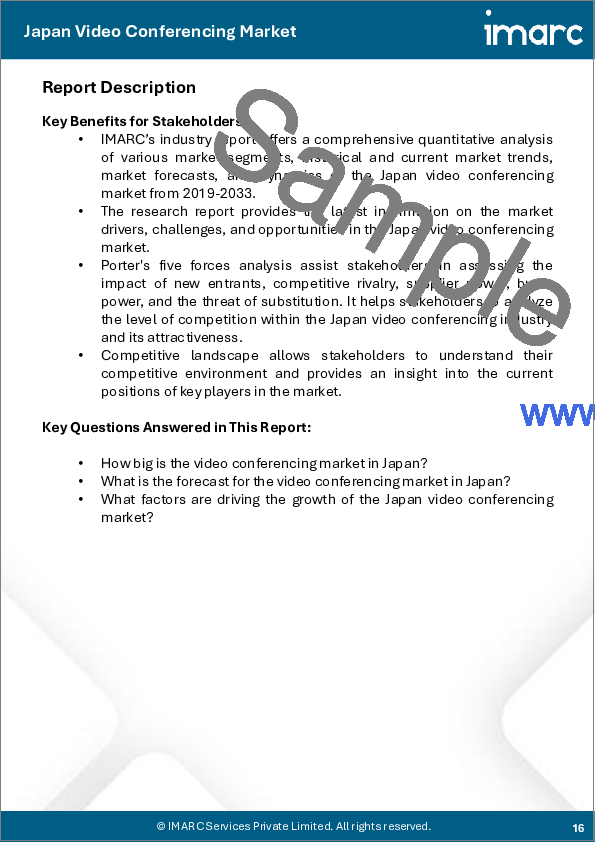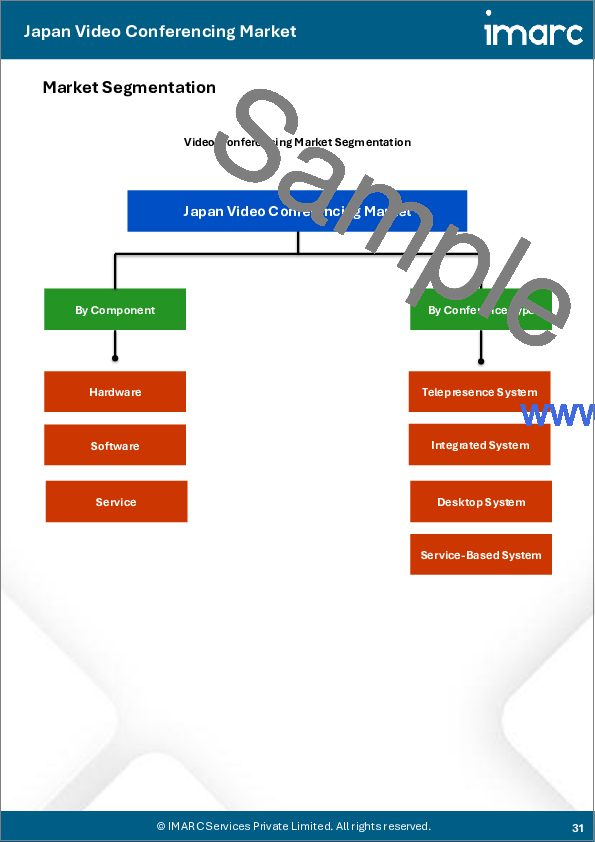|
|
市場調査レポート
商品コード
1746509
日本のビデオ会議市場レポート:コンポーネント別、会議タイプ別、展開モード別、企業規模別、用途別、最終用途別、地域別、2025年~2033年Japan Video Conferencing Market Report by Component, Conference Type, Deployment Mode, Enterprise Size (Large Enterprises, Small and Medium-sized Enterprises ), Application, End Use, and Region 2025-2033 |
||||||
カスタマイズ可能
|
|||||||
| 日本のビデオ会議市場レポート:コンポーネント別、会議タイプ別、展開モード別、企業規模別、用途別、最終用途別、地域別、2025年~2033年 |
|
出版日: 2025年06月02日
発行: IMARC
ページ情報: 英文 121 Pages
納期: 5~7営業日
|
全表示
- 概要
- 目次
日本のビデオ会議市場規模は2024年に7億4,000万米ドルに達しました。今後、IMARC Groupは、同市場が2033年までに15億5,000万米ドルに達し、2025年から2033年にかけて8.54%の成長率(CAGR)を示すと予測しています。サイバーセキュリティとデータプライバシーの重視、リモート学習環境とハイブリッド学習環境の動向の高まり、人工知能(AI)と機械学習(ML)のビデオ会議プラットフォームへの統合は、市場を牽引する重要な要因のいくつかを表しています。
本レポートで扱う主な質問
- 日本のビデオ会議市場はこれまでどのように推移し、今後どのように推移していくのか?
- COVID-19が日本のビデオ会議市場に与えた影響は?
- 日本のビデオ会議市場のコンポーネント別区分は?
- 日本のビデオ会議市場の会議タイプ別区分は?
- 日本のビデオ会議市場の展開モード別の区分は?
- 日本のビデオ会議市場の企業規模別区分は?
- 日本のビデオ会議市場の用途別区分は?
- 日本のビデオ会議市場の最終用途別区分は?
- 日本のビデオ会議市場のバリューチェーンにおける様々なステージとは?
- 日本のビデオ会議の主要な促進要因と課題は何か?
- 日本のビデオ会議市場の構造と主要企業は?
- 日本のビデオ会議市場における競合の程度は?
目次
第1章 序文
第2章 調査範囲と調査手法
- 調査の目的
- ステークホルダー
- データソース
- 市場推定
- 調査手法
第3章 エグゼクティブサマリー
第4章 日本のビデオ会議市場-イントロダクション
- 概要
- 市場力学
- 業界動向
- 競合情報
第5章 日本のビデオ会議市場情勢
- 過去および現在の市場動向(2019~2024年)
- 市場予測(2025~2033年)
第6章 日本のビデオ会議市場- コンポーネント別の内訳
- ハードウェア
- ソフトウェア
- サービス
第7章 日本のビデオ会議市場- 会議タイプ別の内訳
- テレプレゼンスシステム
- 統合システム
- デスクトップシステム
- サービスベースのシステム
第8章 日本のビデオ会議市場- 展開モード別の内訳
- オンプレミス
- クラウドベース
第9章 日本のビデオ会議市場- 企業規模別の内訳
- 大企業
- 中小企業
第10章 日本のビデオ会議市場- 用途別の内訳
- コーポレートコミュニケーション
- トレーニングと開発
- マーケティングと顧客エンゲージメント
第11章 日本のビデオ会議市場- 最終用途別の内訳
- 企業
- 教育
- ヘルスケア
- 政府と防衛
- BFSI
- メディアとエンターテイメント
- その他
第12章 日本のビデオ会議市場-競合情勢
- 概要
- 市場構造
- 市場企業のポジショニング
- 主要成功戦略
- 競合ダッシュボード
- 企業評価象限
第13章 主要企業のプロファイル
第14章 日本のビデオ会議市場- 業界分析
- 促進要因・抑制要因・機会
- ポーターのファイブフォース分析
- バリューチェーン分析
第15章 付録
Japan video conferencing market size reached USD 740 Million in 2024. Looking forward, IMARC Group expects the market to reach USD 1,550 Million by 2033, exhibiting a growth rate (CAGR) of 8.54% during 2025-2033. The growing emphasis on cybersecurity and data privacy, rising trend of remote and hybrid learning environments, and the integration of artificial intelligence (AI) and machine learning (ML) into video conferencing platforms represent some of the key factors driving the market.
Video conferencing is a technology that allows individuals or groups to conduct face-to-face meetings and discussions from different locations in real-time using video and audio communication over the Internet. It enables seamless visual and auditory interaction, bridging geographical gaps. It provides instant, synchronous communication, enabling participants to interact, which be recorded for future reference. It can be accessed on various devices like computers, smartphones, and tablets, making it versatile and accessible. It offers chat features and the ability to exchange files during meetings. It reduces the need for travel, accommodation, and related expenses, saving time and money. It facilitates efficient communication, reducing the time spent in transit and allowing for quicker decision-making. It enables organizations to collaborate with partners, clients, or employees worldwide without geographical limitations. It eliminates carbon emissions associated with commuting and travel, contributing to sustainability efforts. It is widely used for internal team meetings, client consultations, and partner collaborations. It allows healthcare professionals to diagnose and treat patients remotely. Besides this, it is also employed in the corporate sector to conduct job interviews with candidates from diverse locations. Moreover, as it aids in promoting business continuity during unforeseen circumstances, the demand for video conferencing is increasing across Japan.
Japan Video Conferencing Market Trends:
The rising emphasis on cybersecurity and data privacy is encouraging Japanese organizations to invest in video conferencing solutions that offer robust security features to protect sensitive information. Additionally, the increasing use of video conferencing tools in the education sector of the country is offering a favorable market outlook. The growing trend of remote and hybrid learning environments is catalyzing the demand for secure and reliable video conferencing tools for online classes and virtual lectures. Furthermore, the rising adoption of hybrid and remote work modules is strengthening the growth of the market. Businesses are investing in reliable and feature-rich solutions to facilitate seamless collaboration among geographically dispersed teams. Moreover, governing authorities of the country are undertaking several initiatives to promote digitalization and technology adoption in both public and private sectors, which is propelling the market growth. These efforts include subsidies and incentives for businesses to invest in advanced communication technologies to strengthen their communication. Along with this, the integration of artificial intelligence (AI) and machine learning (ML) into video conferencing platforms is facilitating the market growth. Japanese companies are leveraging AI-driven features like real-time language translation, transcription, and facial recognition to enhance the user experience and break down language barriers in international meetings, making video conferencing more inclusive and accessible.
Japan Video Conferencing Market Segmentation:
Component Insights:
- Hardware
- Camera
- Microphone/Headphone
- Others
- Software
- Service
- Professional Services
- Managed Services
Conference Type Insights:
- Telepresence System
- Integrated System
- Desktop System
- Service-Based System
Deployment Mode Insights:
- On-Premises
- Cloud-Based
Enterprise Size Insights:
- Large Enterprises
- Small and Medium-sized Enterprises (SMEs)
Application Insights:
- Corporate Communications
- Training and Development
- Marketing and Client Engagement
End Use Insights:
- Corporate
- Education
- Healthcare
- Government and Defense
- BFSI
- Media and Entertainment
- Others
Competitive Landscape:
The market research report has also provided a comprehensive analysis of the competitive landscape. Competitive analysis such as market structure, key player positioning, top winning strategies, competitive dashboard, and company evaluation quadrant has been covered in the report. Also, detailed profiles of all major companies have been provided.
Key Questions Answered in This Report:
- How has the Japan video conferencing market performed so far and how will it perform in the coming years?
- What has been the impact of COVID-19 on the Japan video conferencing market?
- What is the breakup of the Japan video conferencing market on the basis of component?
- What is the breakup of the Japan video conferencing market on the basis of conference type?
- What is the breakup of the Japan video conferencing market on the basis of deployment mode?
- What is the breakup of the Japan video conferencing market on the basis of enterprise size?
- What is the breakup of the Japan video conferencing market on the basis of application?
- What is the breakup of the Japan video conferencing market on the basis of end use?
- What are the various stages in the value chain of the Japan video conferencing market?
- What are the key driving factors and challenges in the Japan video conferencing?
- What is the structure of the Japan video conferencing market and who are the key players?
- What is the degree of competition in the Japan video conferencing market?
Table of Contents
1 Preface
2 Scope and Methodology
- 2.1 Objectives of the Study
- 2.2 Stakeholders
- 2.3 Data Sources
- 2.3.1 Primary Sources
- 2.3.2 Secondary Sources
- 2.4 Market Estimation
- 2.4.1 Bottom-Up Approach
- 2.4.2 Top-Down Approach
- 2.5 Forecasting Methodology
3 Executive Summary
4 Japan Video Conferencing Market - Introduction
- 4.1 Overview
- 4.2 Market Dynamics
- 4.3 Industry Trends
- 4.4 Competitive Intelligence
5 Japan Video Conferencing Market Landscape
- 5.1 Historical and Current Market Trends (2019-2024)
- 5.2 Market Forecast (2025-2033)
6 Japan Video Conferencing Market - Breakup by Component
- 6.1 Hardware
- 6.1.1 Overview
- 6.1.2 Historical and Current Market Trends (2019-2024)
- 6.1.3 Market Segmentation
- 6.1.3.1 Camera
- 6.1.3.2 Microphone/Headphone
- 6.1.3.3 Others
- 6.1.4 Market Forecast (2025-2033)
- 6.2 Software
- 6.2.1 Overview
- 6.2.2 Historical and Current Market Trends (2019-2024)
- 6.2.3 Market Forecast (2025-2033)
- 6.3 Services
- 6.3.1 Overview
- 6.3.2 Historical and Current Market Trends (2019-2024)
- 6.3.3 Market Segmentation
- 6.3.3.1 Professional Services
- 6.3.3.2 Managed Services
- 6.3.4 Market Forecast (2025-2033)
7 Japan Video Conferencing Market - Breakup by Conference Type
- 7.1 Telepresence System
- 7.1.1 Overview
- 7.1.2 Historical and Current Market Trends (2019-2024)
- 7.1.3 Market Forecast (2025-2033)
- 7.2 Integrated System
- 7.2.1 Overview
- 7.2.2 Historical and Current Market Trends (2019-2024)
- 7.2.3 Market Forecast (2025-2033)
- 7.3 Desktop System
- 7.3.1 Overview
- 7.3.2 Historical and Current Market Trends (2019-2024)
- 7.3.3 Market Forecast (2025-2033)
- 7.4 Service-Based System
- 7.4.1 Overview
- 7.4.2 Historical and Current Market Trends (2019-2024)
- 7.4.3 Market Forecast (2025-2033)
8 Japan Video Conferencing Market - Breakup by Deployment Mode
- 8.1 On-Premises
- 8.1.1 Overview
- 8.1.2 Historical and Current Market Trends (2019-2024)
- 8.1.3 Market Forecast (2025-2033)
- 8.2 Cloud-Based
- 8.2.1 Overview
- 8.2.2 Historical and Current Market Trends (2019-2024)
- 8.2.3 Market Forecast (2025-2033)
9 Japan Video Conferencing Market - Breakup by Enterprise Size
- 9.1 Large Enterprises
- 9.1.1 Overview
- 9.1.2 Historical and Current Market Trends (2019-2024)
- 9.1.3 Market Forecast (2025-2033)
- 9.2 Small and Medium-sized Enterprises (SMEs)
- 9.2.1 Overview
- 9.2.2 Historical and Current Market Trends (2019-2024)
- 9.2.3 Market Forecast (2025-2033)
10 Japan Video Conferencing Market - Breakup by Application
- 10.1 Corporate Communications
- 10.1.1 Overview
- 10.1.2 Historical and Current Market Trends (2019-2024)
- 10.1.3 Market Forecast (2025-2033)
- 10.2 Training and Development
- 10.2.1 Overview
- 10.2.2 Historical and Current Market Trends (2019-2024)
- 10.2.3 Market Forecast (2025-2033)
- 10.3 Marketing and Client Engagement
- 10.3.1 Overview
- 10.3.2 Historical and Current Market Trends (2019-2024)
- 10.3.3 Market Forecast (2025-2033)
11 Japan Video Conferencing Market - Breakup by End Use
- 11.1 Corporate
- 11.1.1 Overview
- 11.1.2 Historical and Current Market Trends (2019-2024)
- 11.1.3 Market Forecast (2025-2033)
- 11.2 Education
- 11.2.1 Overview
- 11.2.2 Historical and Current Market Trends (2019-2024)
- 11.2.3 Market Forecast (2025-2033)
- 11.3 Healthcare
- 11.3.1 Overview
- 11.3.2 Historical and Current Market Trends (2019-2024)
- 11.3.3 Market Forecast (2025-2033)
- 11.4 Government and Defense
- 11.4.1 Overview
- 11.4.2 Historical and Current Market Trends (2019-2024)
- 11.4.3 Market Forecast (2025-2033)
- 11.5 BFSI
- 11.5.1 Overview
- 11.5.2 Historical and Current Market Trends (2019-2024)
- 11.5.3 Market Forecast (2025-2033)
- 11.6 Media and Entertainment
- 11.6.1 Overview
- 11.6.2 Historical and Current Market Trends (2019-2024)
- 11.6.3 Market Forecast (2025-2033)
- 11.7 Others
- 11.7.1 Historical and Current Market Trends (2019-2024)
- 11.7.2 Market Forecast (2025-2033)
12 Japan Video Conferencing Market - Competitive Landscape
- 12.1 Overview
- 12.2 Market Structure
- 12.3 Market Player Positioning
- 12.4 Top Winning Strategies
- 12.5 Competitive Dashboard
- 12.6 Company Evaluation Quadrant
13 Profiles of Key Players
- 13.1 Company A
- 13.1.1 Business Overview
- 13.1.2 Services Offered
- 13.1.3 Business Strategies
- 13.1.4 SWOT Analysis
- 13.1.5 Major News and Events
- 13.2 Company B
- 13.2.1 Business Overview
- 13.2.2 Services Offered
- 13.2.3 Business Strategies
- 13.2.4 SWOT Analysis
- 13.2.5 Major News and Events
- 13.3 Company C
- 13.3.1 Business Overview
- 13.3.2 Services Offered
- 13.3.3 Business Strategies
- 13.3.4 SWOT Analysis
- 13.3.5 Major News and Events
- 13.4 Company D
- 13.4.1 Business Overview
- 13.4.2 Services Offered
- 13.4.3 Business Strategies
- 13.4.4 SWOT Analysis
- 13.4.5 Major News and Events
- 13.5 Company E
- 13.5.1 Business Overview
- 13.5.2 Services Offered
- 13.5.3 Business Strategies
- 13.5.4 SWOT Analysis
- 13.5.5 Major News and Events
14 Japan Video Conferencing Market - Industry Analysis
- 14.1 Drivers, Restraints, and Opportunities
- 14.1.1 Overview
- 14.1.2 Drivers
- 14.1.3 Restraints
- 14.1.4 Opportunities
- 14.2 Porters Five Forces Analysis
- 14.2.1 Overview
- 14.2.2 Bargaining Power of Buyers
- 14.2.3 Bargaining Power of Suppliers
- 14.2.4 Degree of Competition
- 14.2.5 Threat of New Entrants
- 14.2.6 Threat of Substitutes
- 14.3 Value Chain Analysis





